The LePage Family

The original manuscript of this article written by Everest LePage in 1950
Courtesy of Len LePage.
In the year 1852 Mr Nicholas LePage with his wife and son Francis, then less than one year old, arrived in Melbourne from one of the Channel Islands, Guernsey, a British possession lying between the coasts of England and France. Mr LePage was tailor by occupation, and his wife a dressmaker, and, making their home in Prahran, then one of the outer suburbs of Melbourne, started in business there. They remained for about two years; but coming from an island which was almost wholly agricultural, and where almost everything is grown under glass, they decided to shift out to Cheltenham and go on the land.
With this end in view, they obtained a block of land in Two-Acre Village, on Chesterville Road; adjoining the present holding of Cr E A LePage. The Two-Acre Village was part of Holloway’s sub-division, and is one mile square, bounded by Chesterville Road, Bernard Street, Warrigal Road and Centre Dandenong Road, with what is known as Friendship Square in the centre, which was left for a church or school reserve. The whole of the area was subdivided into two-acre blocks. [1]
The district at that time was heavily timbered with box, red gum and wattle, and in this area Mr and Mrs LePage set out to make a living, which they were successful in doing by hard work. The blacks were numerous in the district at this time, as the headquarters of the tribe was at Mordialloc.
On one occasion whilst Mr LePage was visiting King’s Station, on the corner of South and Warrigal Roads, the station was “stuck up” by bushrangers, who took what they required, after tying most of those on the station up. The ploughman, who was working when the raid took place, would not stop his horses when ordered to, so they shot him. Fortunately he only sustained a wound in the arm. The leader of the gang was afterwards captured and hanged in Melbourne Gaol. This was the farthest point south that bushrangers ever came. [2]
The only means of transport to Melbourne at that time was by horse and dray, over very rough bush tracks, or by McCaffery’s bus, which did the trip occasionally.
Nine other children were born to Mr and Mrs LePage, four of whom died young. One daughter married Mr William Woff, and became the mother of Mr Val Woff, well known in Cheltenham. Another married Mr Jim Sharp, who was in the Education Department, and became the mother of Dr C.C. Sharp, surgeon dentist, of Collins Street. Another daughter married one of the Judd family (Mr James Judd), also well known to older residents. The other surviving son, Herbert, became the father of Mr Vic LePage, manager of one of Melbourne’s leading insurance offices.
At least one of the deceased children is buried in the little cemetery - now neglected, and unknown to Cheltenham people of today - in Balcombe Road, just west from Charman Road, the land belonging to the Methodist denomination, and where their church at one time stood. [3]
As Francis LePage grew older he attended a school conducted by Miss Gomme in Wickham Road, Moorabbin, next to where the Methodist Church now stands, with a few other children who by this time had arrived in the district. He also attended the Methodist Sunday School there, until a little later his father, who had been one of the pioneer members of the Church of Christ in Prahran, and a few others in the surrounding district established a little Church of Christ, known as “Chesterville,” near Wickham Road. The building, on the property of Mr Neal, was standing until about two years ago. On one occasion, owing to the dense timber and scrub, Francis was lost all night within a quarter of a mile of his home.
At 14 years of age he was driving his father’s horse and dray to Melbourne with the vegetables they grew - standing backed in to the footpath in Little Collins Street, at the old Eastern Market. At 18 years of age, and the other members of the family growing up, Francis decided to seek work outside, and was employed as a gardener by Mr Budd, who conducted the Brighton Grammar School. It was whilst employed there that the late Sir Thomas Bent and he became friends, a friendship which lasted throughout their lives. Sir Thomas was then on the land also.
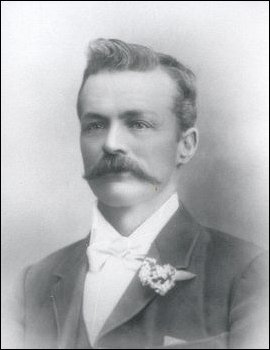
F T LePage, President of Shire of Moorabbin, 1902-03.
During his sojourn in Brighton he became a member of the Brighton Artillery, one of the earliest volunteer forces of the State. This was only natural, as his grandfather had belonged to that crack British Regiment, the Life Guards. Leaving Brighton, Francis went to live in East Melbourne, then the fashionable part of the City, and, being a capable young man in handling horses, became coachman to, at that time one of Melbourne’s biggest bookmakers, “Bill” Branch and his wife, for whom he drove a four-in-hand. It was whilst employed there that he met the young lady who was to be his future wife and the mother of Cr Everest LePage. This young lady, Mary Geraghty, had travelled from Westport, County Mayo, Ireland, at the age of 12, to be with her married sister, who had come out to Australia a year or two earlier after her marriage to Anthony Derrick, and who was feeling lonely in the new land. Anthony Derrick, by the way, became head cutter in the tailoring department of Buckley and Nunn, a position he occupied for 40 years. Mary Geraghty in course of time accepted a position in the home of Judge Wilkinson, Master in Equity, as a parlourmaid, and from there she and Francis LePage were married.
After their marriage by the Rev L. Binks in 1876, they decided to come and live in Cheltenham, and start market gardening, and purchased a block of land in Bernard Street, alongside his father’s homestead. They had the exterior walls of a house erected by a carpenter, and at night, after the day’s work was finished, they completed the interior themselves in lath and plaster. The house still stands on the corner of Bernard and Wilson Streets. Here two sons were born to them - Leopold, who died in infancy and Everest, well known in this and the surrounding districts. As years went on, Frank LePage became known as a successful market gardener; not only that, but he took an active part in everything that was for the advancement of the district. He became a councillor of the then Shire of Moorabbin, a position he held for 25 years, occupying the position of President for a term. He was also a Justice of the Peace, and regularly occupied the Bench at the Cheltenham Court.
In the year 1895, he and a few other gentlemen established the Cheltenham Creamery and Butter Company, and marketed a brand of butter known as “Gilt Edge,” well known at that time throughout the state. The old creamery building is now a private house in Centre Dandenong Road, adjoining Mr Gatford’s property. About the same time he and others established the Cheltenham Co-operative Society, his home in Bernard Street being the first registered office of that Society - a Society that today has a turnover of approximately £100,000. At the time of his death he had been chairman of directors for number of years. Being for 40 years secretary of the Sons of Temperance Friendly Society, it was only natural that he should be one of the founders and a trustee of the Moorabbin United Friendly Societies’ Dispensary.
Prior to this the “Moorabbin News” had been started by Mr Evan Griffiths and his son in a building that was originally the Cheltenham Post Office, on the corner of Chesterville and Pt. Nepean Roads, adjoining what is now Fairbank’s Store. Frank LePage did his utmost to boost the local paper along, as he believed that it would be a great thing for the district in years to come - a faith that has been more than justified.
In 1898 he was one of the founders, a trustee, and later president of the Cheltenham Rifle Club. A rifle range was built in the Cheltenham Park, and shooting was carried on there until the district began to be built on.
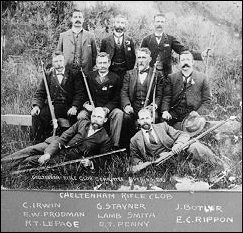
Committee Members of the Cheltenham Rifle Team, F T LePage in back row on right
Courtesy of Eric Longmuir.
About 1902 he was amongst the first members of the Mentone Bowling Club, and in 1908 became one of the first members of the Cheltenham Bowling Club, occupying the position of president in the second year of its existence, and again held the same position for three years in 1916-17. He was champion of the club in 1910. In 1903 he became one of the founders and the first president of the Federal Football League, an organisation now known throughout the State.
In the early part of the century, when Melbourne had the various “pushes” operating in the city and suburbs, Cheltenham also had a “push” known as the “Merry Hawks” - quite harmless, but a thorn in the side of many residents. In an endeavour to provide a meeting place for the lads, and get them off the street, Frank LePage approached his friend, Sir Thomas Bent, who was then Premier of the State, for a monetary grant to assist in providing a building, the outcome being that with the grant Sir Thomas gave, his own, and some friends’ assistance, the billiard room connected with the Mechanics’ Institute was erected. He had previously been associated with the temperance bodies who had erected the large hall adjoining the Mechanics, and which still bears the name.
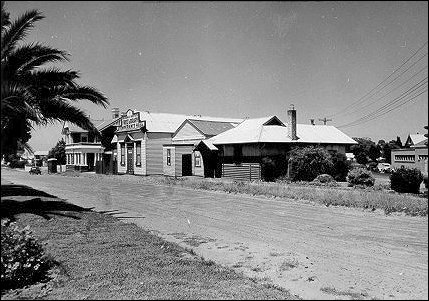
Mechanic’s Institute and Temperance Hall with the Billiard building to the right, 1960.
It was only natural that being on the land, he should be one of those who formed the first Market Gardeners’ Association, and also held office on the Market Gardeners’ Picnic Committee (a separate body) from its inception until his death. For over a quarter of a century he was connected with the Hospital Saturday movement, and when it became the Lord Mayor’s Hospital Fund he was one of the foundation members. About the year 1890 he was elected a Life Governor of the Alfred Hospital for services rendered.
Francis Thomas LePage passed away on December 12, 1927, and his wife, who had always been of the greatest assistance to him, died in 1931. Truly a wonderful record of service to the community, not only in their own district, but elsewhere as well.
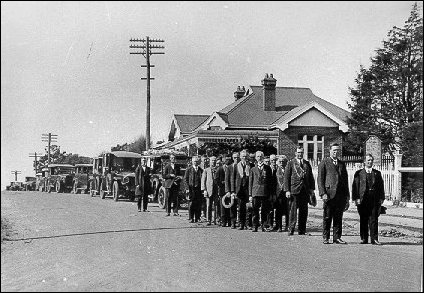
Funeral procession of F T LePage leaves the Cheltenham Church of Christ, December 1927. Courtesy of the Moorabbin Historical Society.
Their son, Everest, was educated at the Moorabbin State School, and later at the Mentone College, under T.R. McCristal, and at an early age began to take an active interest in various local affairs. [4] As a lad, being a elocutionist, he took part in many local entertainments. At the age of 16 he joined the Cheltenham Rifle Club, a very strong club of about 100 members, and at 17 was elected secretary of the club, which office he held for 10 years. During that time he became an expert rifle shot, shooting in many parts of the State. During this time he also took a keen interest in miniature rifle shooting, becoming captain of the Sons of Temperance rifle team, and during one season’s shooting made what was believed to be a world’s record for night shooting, averaging 24 out of possible 25 for 14 matches. He later joined the Australian Natives Association and held the office of president of the Cheltenham branch, also becoming captain of their rifle team. On one occasion he put on 32 consecutive bullseyes - the bullseye being the size of sixpence.
In 1908 he joined the Victorian Rangers, rising to the rank of Lieutenant and Quartermaster. At about the same he formed the 1st Cheltenham Troop of Boy Scouts, there being at that time no Scout Troop further south than Richmond.
Cr Everest LePage married Miss Lynda Anderson, a daughter of Mr and Mrs R. Anderson, the well-known breeders of Jersey cattle, of Lyndhurst and Murrumbeena. Miss Anderson’s grandmother, Mrs W. Greaves, was one of the first children born in Melbourne, having been born in “Canvas Town,” in Collins St. Thus two of Victoria’s pioneer families became united.
After the death of his parents, Everest LePage continued to take an even greater interest in the affairs of the district. For 15 years he has been a councillor of the City of Moorabbin, being elected Mayor in 1940 and a Justice of the Peace the same year.
After the outbreak of war in 1939, the Red Cross Emergency Service was formed, and Mrs LePage was appointed Superintendent, conducting classes throughout the City of Moorabbin, driving herself night after night to the various centres. This, together with her duties as Mayoress the following year, affected her health, and she was compelled to resign as Superintendent; but she continued to take an interest in the Cheltenham Victory Club, of which she was the first president.
During the war years, 1939-45, Cr LePage was Area Warden for Cheltenham in the A.R.P., a member of the local Transport Committee, and a member of the War Agricultural Committee, which controlled machinery, electricity, and manpower in the districts between Oakleigh and Frankston. Being a vegetable grower, Cr LePage has been associated with the present Vegetable Growers’ Association since its inception, and has occupied the position of president. At the present time he is a vice-president, and is also a vice-president of the Market Gardeners’ Picnic Committee. He has always taken a keen interest in the production of high class vegetables and flowers, and has been a constant exhibitor at the Royal Agricultural Show for the past 35 years; as well as at local shows. Three of his sons who are in the business are also keen exhibitors. Cr LePage also acts as judge at a number of country shows. Some of the land being worked by him in Cheltenham has been in continuous production for just on 100 years. This has been accomplished by judicious manuring and a rotation of crops. The fourth generation of the family is now obtaining excellent crops off it.
Cr and Mrs LePage have six children (four boys and two girls), four of whom are married; and they have seven grandchildren, all living in the district. In an endeavour to help and develop Cheltenham as a shopping centre, the family purchase all the goods they can locally, as it is their belief that if all residents could be induced to do likewise, Cheltenham could be made a shopping centre second to none.
In addition to the public interests already mentioned in which Cr LePage is and has been engaged, he was for two years president of the Federal Football League, and for three years president of the Cheltenham Bowling Club, and is at the present time chairman of the State School Committee, a Government nominee on the Advisory Council of the Mordialloc-Chelsea High School, chairman of the Cheltenham War Memorial Committee, member of the Board of Management of the Melbourne Home and Hospital for the Aged and Infirm, director of the Cheltenham and District Co-operative Society, member of the Council of the Victorian Baby Health Centres’ Association, and a trustee of the following organisations: Cheltenham and Mordialloc Community Hospital, Cheltenham Mechanics’ Institute, Cheltenham Cemetery Trust, Moorabbin United Friendly Societies’ Dispensary, Church of Christ, Sons of Temperance, Cheltenham Bowling Club, Heatherton Recreation Reserve, A.R.P. Patriotic Fund, Moorabbin City Band, and the Moorabbin Municipal Band.
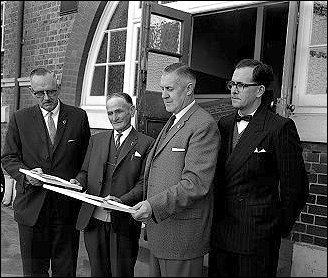
Presentation of long service certificate to Cr Everest LePage for 30 years service to Cheltenham State School. Mr Volk, headmaster, Cr LePage, Mr C Simpson and Mr J Sullivan. From Leader Collection.
For the past 22 years Cr LePage has been associated with the Lord Mayor’s Hospital Fund, and last Hospital Saturday, with the assistance of other growers, collected the sum of £179 for the Lord Mayor’s Fund - an all-time record for the Victoria Market. He was also responsible for the inauguration of the Empire Service, which has been held in Cheltenham for a number of years.
His memory goes back to the time when there were only two shops in Charman Road - Mr W.P. Fairlam’s, and Bert Walker’s grocer’s shop beside it, where Mr Jack Barker’s boot shop now is, the original shop having been destroyed. The remainder of the east side of Charman Road was a paddock, and on the area between where Station Street now is and Park Road was the Cheltenham cricket ground. Prior to this the cricket ground had been in the Cheltenham Park, where the new Western Oval now is, near the Victoria Golf Club. The Cheltenham Football Club at this time played in Keighran’s paddock, on the corner of Centre Dandenong Road and Nepean Highway. On the opposite corner was Keighran’s Hotel, since pulled down.
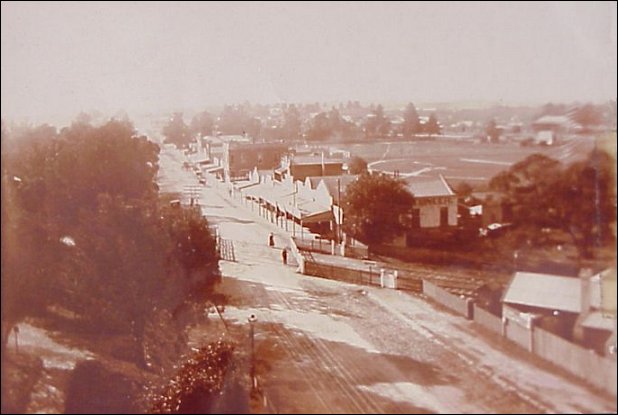
Charman Road, Cheltenham with the cricket ground behind the shops. Photograph by P. Fairlam courtesy of Betty Kuc.
South of the railway in Charman Road was Mr Meere’s shop (the present Dispensary), and three houses on the hill southward opposite Dr. Hudson’s new home. One house still remains, and this was the residence of Dr. Moore one of Cheltenham’s early medical men. The other one lived in a house now owned by Cr LePage on the corner of Chesterville Road and Jellicoe Street (then called Patrick Street). This was the residence of Dr. Shields. The original “hitching post” for horses, and on which was a red light, still remains on the edge of the footpath there. In the early 90s the late Dr. Scantlebury came to live in Cheltenham, in the house on Nepean Highway which is now the Cato Boys’ Home, and commenced to build up a practice in the district.[5]
All the shopping was done on Nepean Highway. Beazley’s butcher’s shop, Sinclair’s bakery (later Geo. Rose’s), Reynold’s saddlery, Fletcher’s grocery and a draper’s shop where the old Bank of Victoria now stands, and the late Mr T. Chandler’s boot shop (including the Post Office and newsagent’s, which he conducted on the corner of Chesterville Road and Nepean Highway), the Court House, Morris Exchange Hotel, and Keighran’s Hotel were all there at this time, and Corstorphan’s grocery (which was burnt down) where the Co-operative Store now is.
The Presbyterian Church, St. Matthew’s and the Church of Christ were all in their present positions. The Methodist Church, previously mentioned in Balcombe Road was transferred to Charman Road to where Mr Young’s hardware store now is, and was destroyed by fire one Sunday after the morning service. [6] Another building was erected near the corner of Charman Road and Weatherall Road which is now used as a dwelling, and the present building in Charman Road followed.
The biggest event of the year in Cheltenham was the Friendly Societies’ Gala, which included a fancy dress and decorated vehicles procession from Cheltenham via Charman and Balcombe Roads to the Mentone Skating Rink grounds (now the Mentone Oval).

Everest LePage at Friendly Societies Gala Day at Mentone Recreation Reserve. Courtesy of Len LePage.
Cr LePage in his young days took a keen interest in cycling, being one of the original members of the Cheltenham Bicycle Club. Previous to this he won a race on the Mentone Oval at the Queen Victoria Diamond Jubilee celebrations in 1897, and took part in the first road race held in Cheltenham in 1900 - a five-mile race to Aspendale - which he won, hitting a dog on the way and going over the handlebars, but was uninjured.
While being associated with all these activities of the district, both Mr Frank LePage and his son, Everest, have had to attend the Victoria Market, and whilst driving horses had to leave home at 11 o’clock at night, returning about midday next day. This was done two or three nights each week. After motor transport took the horse’s place, it was nothing unusual for Cr LePage to go home from a meeting, change his clothes and go straight off to market, following up with a meeting again the next night, and this was his routine for years. During recent years his sons have relieved him of the market work.
Cr LePage believes that success in life is not measured by the wealth one may accumulate, but by what you can do for other people. “As we shall pass through this world but once, any good thing that we can do, or any kindness that we can show to any human being, let us not defer it or neglect it, for we shall not pass this way again.”
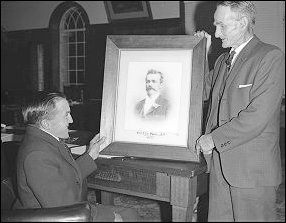
Three Councillors, Everest LePage shows his son, Frank, a portrait of his grandfather.
From Leader Collection
Footnotes
- see Two Acre Village – Article Ref 186.
- see Bushrangers Creating Havoc – Article Ref 125. The ploughman died as a result of the wound and the two bushrangers were captured and hanged.
- see Beaumaris Cemetery – Article Ref 108. Several LePage children were buried in the Beaumaris Cemetery.
- see Mentone College and Thomas McCristal – Article Ref 53.
- Cato House was part of the Methodist Children’s Home, which is now the site of Westfield’s Southland at Cheltenham.
- The site of Mr Young’s hardware store in 2002 is Nello’s Trattoria in Charman Road.
- First published in the Moorabbin News - Golden Jubilee Edition - Thursday, March 30, 1950.
